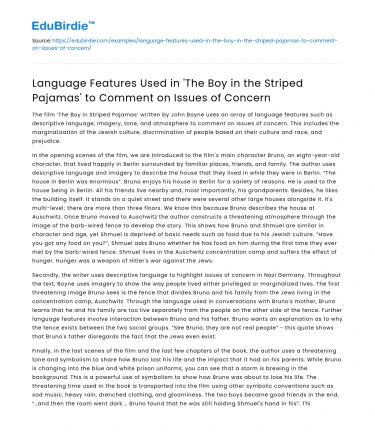The film ‘The Boy in Striped Pajamas’ written by John Boyne uses an array of language features such as descriptive language, imagery, tone, and atmosphere to comment on issues of concern. This includes the marginalization of the Jewish culture, discrimination of people based on their culture and race, and prejudice.
In the opening scenes of the film, we are introduced to the film's main character Bruno, an eight-year-old character, that lived happily in Berlin surrounded by familiar places, friends, and family. The author uses descriptive language and imagery to describe the house that they lived in while they were in Berlin. “The house in Berlin was enormous”. Bruno enjoys his house in Berlin for a variety of reasons. He is used to the house being in Berlin. All his friends live nearby and, most importantly, his grandparents. Besides, he likes the building itself. It stands on a quiet street and there were several other large houses alongside it. It's multi-level; there are more than three floors. We know this because Bruno describes the house at Auschwitz. Once Bruno moved to Auschwitz the author constructs a threatening atmosphere through the image of the barb-wired fence to develop the story. This shows how Bruno and Shmuel are similar in character and age, yet Shmuel is deprived of basic needs such as food due to his Jewish culture. “Have you got any food on you?”, Shmuel asks Bruno whether he has food on him during the first time they ever met by the barb-wired fence. Shmuel lives in the Auschwitz concentration camp and suffers the effect of hunger. Hunger was a weapon of Hitler's war against the Jews.
Save your time!
We can take care of your essay
- Proper editing and formatting
- Free revision, title page, and bibliography
- Flexible prices and money-back guarantee
Secondly, the writer uses descriptive language to highlight issues of concern in Nazi Germany. Throughout the text, Boyne uses imagery to show the way people lived either privileged or marginalized lives. The first threatening image Bruno sees is the fence that divides Bruno and his family from the Jews living in the concentration camp, Auschwitz. Through the language used in conversations with Bruno's mother, Bruno learns that he and his family are too live separately from the people on the other side of the fence. Further language features involve interaction between Bruno and his father. Bruno wants an explanation as to why the fence exists between the two social groups. “See Bruno, they are not real people” - this quote shows that Bruno's father disregards the fact that the Jews even exist.
Finally, in the last scenes of the film and the last few chapters of the book, the author uses a threatening tone and symbolism to share how Bruno lost his life and the impact that it had on his parents. While Bruno is changing into the blue and white prison uniforms, you can see that a storm is brewing in the background. This is a powerful use of symbolism to show how Bruno was about to lose his life. The threatening time used in the book is transported into the film using other symbolic conventions such as sad music, heavy rain, drenched clothing, and gloominess. The two boys became good friends in the end, “…and then the room went dark … Bruno found that he was still holding Shmuel's hand in his”. This is a powerful language feature that portrays the importance of friendship between Bruno and Shmuel. The strong opening line of the final chapter in the novel, “Nothing more was heard of Bruno after that”, shows how the family could not get over Bruno's death.
‘The Boy in Striped Pajamas’ uses an array of language features such as descriptive language, imagery, tone, and atmosphere to comment on issues of concern. This includes the marginalization of the Jewish culture, discrimination of people based on their culture and prejudice.






 Stuck on your essay?
Stuck on your essay?

